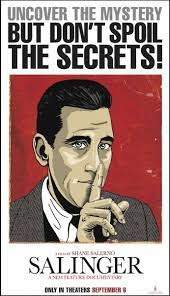
SALINGER
US, 2013, 120 minutes, Colour.
Directed by Shane Salerno.
J.D.Salinger was a key figure in American literature in the 20th century, not only the writing itself, but the enormous impact of his novel, The Catcher in the Rye. In his later decades, Salinger was something of a recluse, a mysterious figure, still writing, speculation about unpublished writings, journalists trying to contact him. He died in 2010 at the age of 91.
This is an extensive documentary, giving the background of Salinger and his family, the influences on his growing up, his initial writing, a relationship with Oona O’Neill and the disappointment when she suddenly married Charlie Chaplin, his war service, detailed from D-Day to the concentration camp openings and V-Day in Europe.
There is a vast range of talking heads throughout the film, several biographers, although this film is based on the work of one of them, Paul Alexander, who appears throughout the film. The range of literary critics as well, other novelists and playwrights including John Guare, A. E Hotchner, E.L. Doctorow, Tom Wolfe. There are interviews with a number of friends over the years, especially Jean Miller who, as a young girl, had quite an influence on Salinger. There are interviews with his estranged daughter, Margaret, some more favourable comment from his son, Matthew. There is background material on his first wife, Sylvia, a German with Nazi background, migrating with him to the US and soon after separating. There is more background on his second wife, Claire, sympathetic for her life, his neglect of her, the ultimate divorce. Only brief glimpses of his third wife, Colleen. But there are long interviews with author, Joyce Maynard, contacted by Salinger and eventually living with him for a while but, ultimately denounced by him.
Also a number of talking heads from the entertainment industry, interesting comments from Martin Sheen, brief comments from Philip Seymour Hoffman, John Cusack, Edward Norton. Interestingly, he allowed one of his stories to be filmed by producer Samuel Goldwyn but was dismayed with the result, My Foolish Heart.
So, with many visuals, photos, film clips (including filming of rehabilitation of veterans at the end of the war), recreations of some episodes in Salinger’s life, background footage from the various periods which recreates the atmosphere of those periods.
Extensive background is given to Salinger’s writing career, early short stories and publications, his war experiences, letters home, the impact of the short stories after the war and his acclaim, his career with the New Yorker. There is a lot of comment, naturally, on the writing of The Catcher in the Rye, how it relates to Salinger himself and his personality, his war experiences. It was published when he was in his Early 30s – and young readers of the 1950s and, then, especially in the 1960s, resonated with his character, Holden Caulfield.
While Salinger could be very sociable, especially with his friends, dining out, going to clubs, he was also reticent, especially concerning writing and his career, shunning book tours, shunning the media, something which continued until his death. But, he was committed to writing, whether it was read or not, writing for himself.
This documentary also gives the background of his writing Franny, eventually of his writing Zooey, the writing of Raise High the Roofbeams, Carpenter and other stories.
The episode with Joyce Maynard is given highlights, with a long interview with her, calmly telling of her time with Salinger, then expressing her disappointment, information about his writing to other young women, including an au pair girl whom he ultimately marries. There is some final footage with some journalists actually meeting him just before his death, and photos of him in old age.
The film gives information about the novels and stories which he had labelled ready for publication. There is also his foundation with rights over all his writings – and the forbidding of any film version of The Catcher in the Rye. The list of approved works for publication list dates after the making of this film, from 2015 on.
This documentary is an excellent opportunity to learn something about Salinger and provides a basis for further research and understanding.